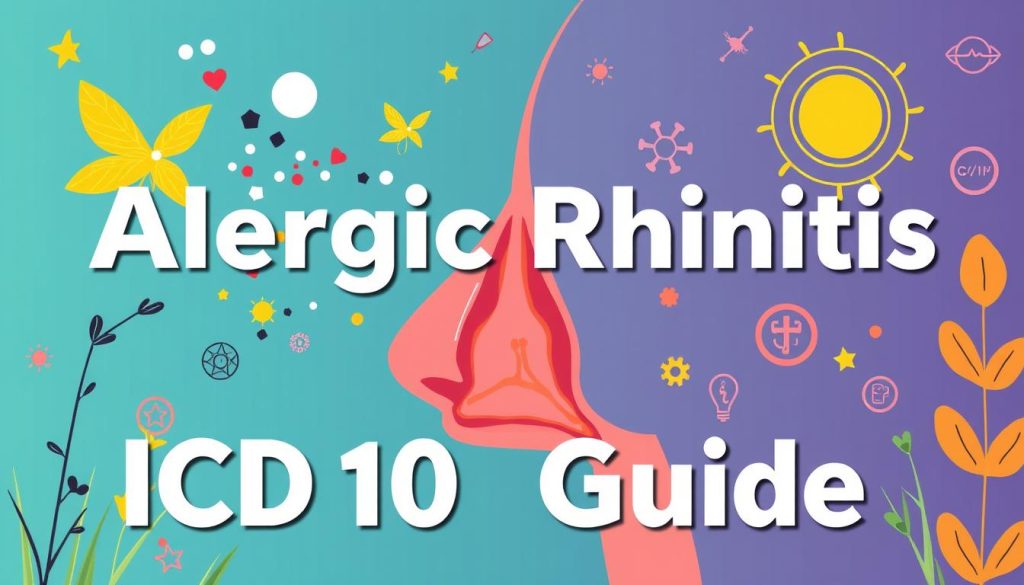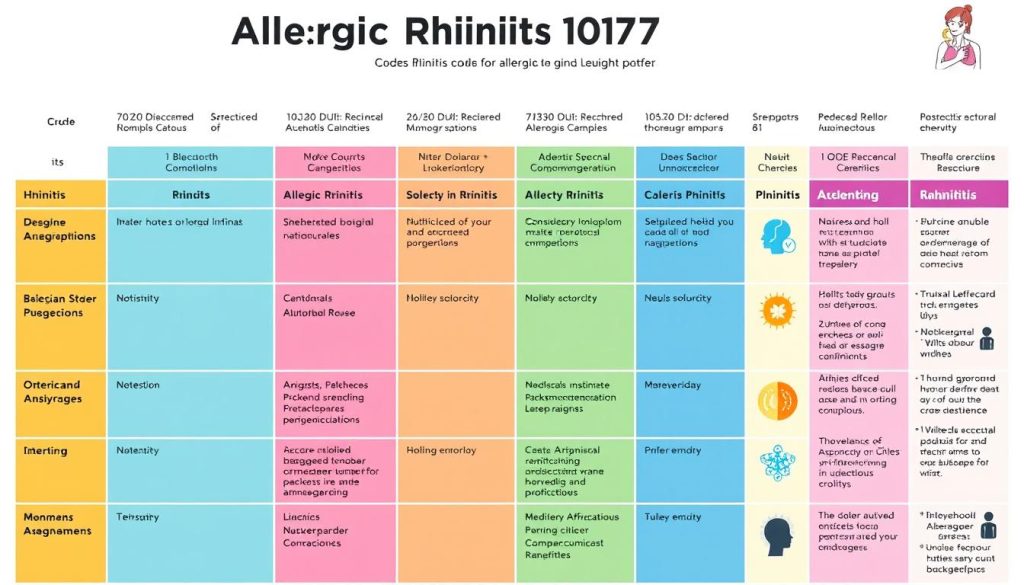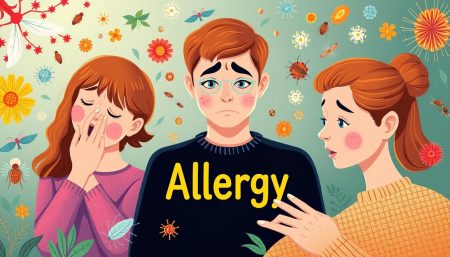Starting to understand allergic rhinitis ICD 10 medical coding is like navigating a complex map. It connects patients’ symptoms with the care they need. This guide is more than just a list of codes. It’s a light that helps everyone, from doctors to patients, understand the ICD 10 system.
Healthcare providers use nasal allergy diagnosis to give the right treatment. Every number and letter in rhinitis ICD 10 CM coding matters for those with allergic rhinitis.
Key Takeaways
- Grasp essential knowledge of allergic rhinitis and its impact on medical coding standards.
- Understand the role of accurate ICD 10 coding in effective nasal allergy diagnosis and management.
- Explore the significance of the rhinitis ICD 10 CM codes in healthcare documentation and reimbursement.
- Promote best practices in the coding process, ensuring detailed and precise patient data.
- Facilitate accessible communication between the medical community and patients through clear coding guidelines.
Understanding Allergic Rhinitis and ICD 10 Coding
Learning about allergic rhinitis and its ICD 10 coding is key for doctors and patients. This part covers the basics of allergic rhinitis, its common causes, and the ICD 10 system. It’s important for accurate medical records.
The Basics of Allergic Rhinitis
Allergic rhinitis is a common condition worldwide. It’s caused by allergens like pollen, dust, and pet dander. Knowing these causes helps both patients and doctors manage symptoms better.
Overview of ICD 10 System
The ICD 10 coding system is a global standard for health conditions. It includes specific codes for allergic rhinitis. Using these codes correctly is crucial for patient care and research.
Doctors need to know the ICD 10 codes for allergic rhinitis. This ensures accurate coding. It helps in better patient care and improves health statistics worldwide.
| ICD 10 Code | Description |
|---|---|
| J30.1 | Allergic Rhinitis caused by pollen |
| J30.2 | Other seasonal allergic rhinitis |
| J30.3 | Other allergic rhinitis (Perennial) |
| J30.9 | Allergic rhinitis, unspecified |
Allergic Rhinitis ICD 10
When doctors see patients with sneezing, itching, and stuffy noses, they use allergic rhinitis ICD 10 codes. These codes help with accurate diagnosis and billing. It’s important to know if it’s seasonal or perennial allergic rhinitis because it affects the hay fever codes used.
Seasonal allergic rhinitis is caused by pollen from trees, grasses, or weeds. It has specific hay fever codes based on the pollen type and season. Perennial allergic rhinitis, caused by dust mites, pet dander, or mold, has different codes. Knowing this helps doctors give better care and helps with insurance claims.
| Allergic Rhinitis Type | ICD 10 Code | Description |
|---|---|---|
| Seasonal | J30.1 | Allergic rhinitis caused by pollen |
| Perennial | J30.2 | Allergic rhinitis caused by other allergens |
| Unspecified | J30.9 | Allergic rhinitis, unspecified |
The allergic rhinitis ICD 10 guidelines help doctors diagnose and manage the condition better. They also help educate patients about their condition. So, using the right hay fever codes is crucial for patient care.

Identifying Allergic Rhinitis Symptoms for Accurate Coding
Healthcare professionals need to spot the signs of allergic rhinitis to code it right. A thorough check helps in pinpointing the right nasal allergy diagnosis. It also shapes the best allergic rhinitis treatment plans.
Common Symptoms of Allergic Rhinitis
Common signs include sneezing, stuffy nose, runny nose, and itchy eyes. These signs are key for a solid diagnosis. They also play a big role in coding accuracy.
Distinguishing Seasonal and Perennial Symptoms
Knowing the difference between seasonal and perennial allergic rhinitis is crucial. Seasonal types are caused by pollen and happen at certain times. Perennial types last all year, often due to dust mites, pet dander, or mold.
| Seasonal Allergic Rhinitis | Perennial Allergic Rhinitis |
|---|---|
| Occurs during specific seasons | Persists throughout the year |
| Triggered by outdoor allergens like pollen | Commonly caused by indoor allergens like dust mites |
| Symptoms: sneezing, watery eyes | Symptoms: constant nasal congestion, itchy eyes |
| Coding focuses on seasonal exposure | Coding must highlight chronic exposure |
Decoding Hay Fever Codes in ICD 10
Exploring rhinitis icd 10 cm coding, we find it’s key to know the differences between seasonal allergic rhinitis and other allergies. Accurate coding helps track diseases and guide treatments.
Seasonal Allergic Rhinitis Coding
Seasonal allergic rhinitis, or hay fever, makes people more sensitive in certain seasons. This is mainly because of pollen from plants. The ICD 10 CM has special codes for this, helping doctors diagnose and treat better.
- Spring allergies are coded differently than fall allergies.
- Knowing when plants bloom and what grows in your area is important for coding.
Getting the right code for seasonal allergic rhinitis is crucial for patient care. It lets doctors plan treatments that match the season. This can include special shots or ways to prevent symptoms.
Challenges in Coding Overlapping Symptoms
One big challenge in rhinitis icd 10 cm coding is telling apart symptoms that can look like other conditions. This is key for the right treatment and care. It includes:
- Telling apart perennial and seasonal causes.
- Figuring out if symptoms are like asthma or sinusitis.
Dealing with these issues means doctors need to know a lot about each patient. They must also keep up with new ways of coding and diagnosing.
Key Factors in Nasal Allergy Diagnosis
Getting a proper nasal allergy diagnosis is key to treating allergic rhinitis well. Knowing what affects this process can make diagnoses more accurate.
First, doctors need to look at a patient’s history closely. They check for patterns in symptoms and how bad they are. This can often be linked to seasons or certain places.
Also, they do a detailed check of symptoms. This helps tell if it’s allergic rhinitis or something else.
For allergic rhinitis treatment, it’s important to know the difference from other conditions. Doctors might use tests like skin or blood tests, or look inside the nose with a special tool.
- Reviewing environmental exposures and patient interaction with common allergens
- Evaluating the frequency and intensity of nasal symptoms
- Assessing patient history regarding allergic reactions
It’s also key to record allergic rhinitis correctly in medical records. Using the ICD-10-CM code J30.2 for seasonal allergic rhinitis helps doctors plan better care.
Accurate diagnosis is the cornerstone of effective allergic rhinitis treatment, profoundly influencing patient quality of life.
Knowing these steps helps doctors give better care and teaches patients how to manage their symptoms. Learning about allergic rhinitis treatment and nasal allergy diagnosis helps make better health choices.
Best Practices for Allergic Rhinitis Treatment Coding
In healthcare, coding treatments well is key for managing allergic rhinitis. This part talks about the best ways doctors can code treatments for allergic rhinitis accurately.
Incorporating Treatment Types
Allergic rhinitis has many treatments, like medicines and procedures. Coding these treatments right helps manage patients better. It also helps track how well treatments work for different people.
For example, using ICD-10 codes for immunotherapy helps doctors keep track of its success. This makes sure treatments fit and work well for each patient.
Documentation for Reimbursement
Good documentation is key for getting paid back. Doctors must write down every detail of diagnosis and treatment. This includes symptoms, why they think it’s allergic, what treatment they chose, and follow-up plans.
With more focus on allergies in healthcare, detailed documentation and coding are more important. They help make care better and more reliable worldwide.

Exploring Allergic Rhinitis Causes and ICD 10 Codes
Understanding the causes of allergic rhinitis is key for correct coding. This part explains how both environment and genes play a role in allergic rhinitis causes. It also shows how these factors are linked to specific ICD 10 codes.
Environmental and Genetic Factors
Pollen, mold, animal dander, and dust mites are common allergens. They are everywhere and can cause symptoms all year. Family history also matters, as it can raise your risk of getting allergic rhinitis.
Linking Causes to Accurate Coding
Finding out what allergens cause symptoms is crucial for coding. Knowing the link between environmental or genetic factors and allergic reactions helps doctors use the right ICD 10 codes.
Below is a table showing common environmental triggers of allergic rhinitis and their ICD 10 codes:
| Allergen | ICD 10 Code | Description |
|---|---|---|
| Pollen | J30.1 | Allergic rhinitis caused by pollen |
| Dust mites | J30.3 | Allergic rhinitis due to dust mites |
| Animal dander | J30.81 | Allergic rhinitis due to animal (cat) (dog) hair and dander |
| Mold | J30.2 | Allergic rhinitis caused by mold |
Linking allergic rhinitis causes to the right codes is vital. It ensures accurate treatment plans and patient records. This is crucial for efficient healthcare.
Rhinitis ICD 10 CM: Diving Deeper into the Codes
Understanding rhinitis ICD 10 CM codes is key. It’s about knowing the conditions and the fine details that make each code unique. This is vital for those who diagnose nasal allergies to ensure they get it right and bill correctly.
The table below breaks down rhinitis codes. It helps healthcare workers make accurate diagnoses and reports:
| Code | Description | Notes |
|---|---|---|
| J30.1 | Allergic rhinitis due to pollen | Used for seasonal allergies confirmed by specific testing |
| J30.2 | Other seasonal allergic rhinitis | Covers allergens other than pollen, during specific seasons |
| J30.3 | Other allergic rhinitis | Perennial allergies triggered by indoor substances |
| J30.4 | Allergic rhinitis, unspecified | Used when allergens are not confirmed or are mixed |
The rhinitis ICD 10 CM system is detailed. It accounts for every type of rhinitis, whether it’s seasonal or perennial. This helps doctors not just diagnose but also plan the best treatment for nasal allergies.
Using these codes correctly helps match treatments to patients’ needs. This makes patient care better and medical records more accurate. It’s important for both patient care and dealing with insurance.
It’s also important for doctors to keep up with ICD 10 CM updates. This ensures their coding practices are based on the latest research in nasal allergy diagnosis.

Allergic Rhinitis Management: Coding for Long-Term Care
Effective allergic rhinitis management and coding are key for patients to get ongoing allergic rhinitis treatment. This part looks into long-term care planning and the ICD 10 codes that help these ongoing care plans.
Long-Term Treatment Strategies
Handling allergic rhinitis well means tackling symptoms, causes, and preventing them from coming back. This includes managing medicines, changing lifestyles, and seeing doctors often.
Monitoring and Follow-Up Coding
Keeping an eye on patients and regular check-ups are key in managing allergic rhinitis long-term. Using the right ICD 10 codes is important for tracking care and getting paid for it.
| Treatment Type | ICD 10 Code | Frequency of Care |
|---|---|---|
| Medication Adjustments | J30.9 | Bi-annual Review |
| Allergen Immunotherapy | J30.1 | Monthly Sessions |
| Environmental Control Counselling | Z71.3 | Annual Check-up |
By using these long-term care plans and correct coding, doctors can make sure all parts of allergic rhinitis care are covered. This helps patients get better and makes care easier to manage.
Tips for Staying Updated with ICD 10 Modifications
Healthcare is always changing, and knowing the latest medical coding updates is key. This is especially true for those working with allergic rhinitis ICD 10 codes. Changes can affect how we code, which impacts payments and patient records.
To stay on top, here are some tips for keeping up with ICD 10 changes:
- Subscribe to newsletters from groups like the World Health Organization (WHO) and the Centers for Medicare & Medicaid Services (CMS). They often share updates on ICD 10 codes.
- Join webinars and workshops on ICD 10 updates. Experts lead these, offering practical tips on new codes.
- Use social media and professional networks to share allergic rhinitis ICD 10 updates with others.
- Keep your coding software and tools updated. They often change to match new coding rules.
Also, staying active in medical coding education helps a lot. This is especially true for codes like allergic rhinitis. Symptoms and treatments can change, so codes need to update too.
| Resource | Description | Benefits |
|---|---|---|
| ICD 10 CM Official Coding Guidelines | Comprehensive guide provided by CMS and the NCHS | Ensures compliance and enhances coding accuracy |
| Annual Coding Workshops | Sessions that focus on new codes and revisions | Direct learning from industry experts |
| Online Forums | Platforms where coders share insights and resolve queries | Peer-to-peer assistance and real-time advice |
By making these practices part of their work, coders can handle allergic rhinitis ICD 10 coding well. This helps make medical records and patient care more reliable. In a field where accuracy is crucial, staying informed is essential.
Conclusion
Understanding allergic rhinitis ICD 10 coding is a journey that requires dedication and care for those affected. This article has given a detailed guide on symptoms, causes, and coding practices. These are key to better patient care and accurate billing.
For healthcare workers, knowing ICD 10 codes for allergic rhinitis is crucial. It shows a commitment to providing the right treatments quickly. By using good coding practices, professionals help make healthcare more precise and efficient.
Staying updated on allergic rhinitis ICD 10 codes is very important. Accurate coding is the base for quality care and better treatment results. We must keep learning and care for those with allergic rhinitis, upholding our values as caregivers.
FAQ
Q: What is allergic rhinitis and how is it coded in ICD 10?
A: Allergic rhinitis is when the nasal passages get inflamed because of an allergic reaction to things in the air. In ICD 10, it’s coded based on if it’s seasonal or lasts all year. It also depends on knowing the allergen.
Q: Why is it important to differentiate between seasonal and perennial allergic rhinitis in ICD 10 coding?
A: It’s key to tell the difference in ICD 10 coding for seasonal and perennial allergic rhinitis. This helps plan treatment and get the right payment. Seasonal rhinitis happens at certain times, while perennial rhinitis is all year.
Q: What are the common symptoms of allergic rhinitis?
A: Symptoms of allergic rhinitis include sneezing, stuffy nose, and runny nose. Itchy eyes, nose, or throat and postnasal drip are also common. These symptoms can change with the seasons and vary in how bad they are.
Q: How do environmental and genetic factors affect the coding of allergic rhinitis?
A: Things like pollen, dust, and pet dander, and your genes, can start allergic rhinitis. These should be thought about when coding for the right treatment and ways to avoid allergies.
Q: What challenges do overlapping symptoms present in ICD 10 coding for allergic rhinitis?
A: Symptoms of allergic rhinitis can be the same as other conditions like non-allergic rhinitis or colds. It’s important to record symptoms, history, and test results well for the right code.
Q: How should ICD 10 codes be applied for long-term management and treatment of allergic rhinitis?
A: For long-term care, ICD 10 codes should show the ongoing treatment and the allergen if known. They should also show the treatment type, like shots or medicine. Keeping up with follow-ups and checks is crucial.
Q: Why is continuous updating with ICD 10 modifications important for those coding allergic rhinitis?
A: Keeping up with ICD 10 changes is key for correct coding. It affects how we diagnose and treat, and how we bill insurance. It keeps patient care up to date in a changing medical world.
Q: What are some best practices for coding allergic rhinitis treatments?
A: To code treatments well, document the medicines or therapies used. Note how often and for how long they’re used. Make sure codes are current with ICD 10 updates for payment.
Q: How can healthcare professionals accurately code nasal allergy diagnoses?
A: Healthcare pros can code nasal allergies right by checking patient history and symptoms. They should get test results to confirm allergens. Then, they use the right codes based on what they find.
Q: How does proper ICD 10 coding of allergic rhinitis impact patient care?
A: Correct ICD 10 coding for allergic rhinitis helps doctors talk clearly about a patient’s condition. It leads to better treatment plans and right insurance payments. This improves patient care quality and keeps it going smoothly.


















